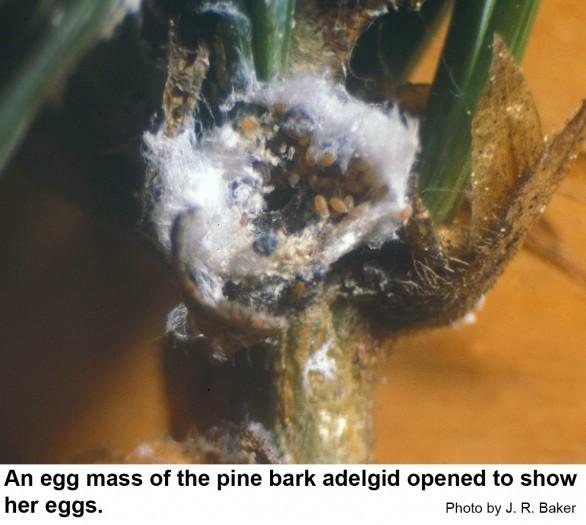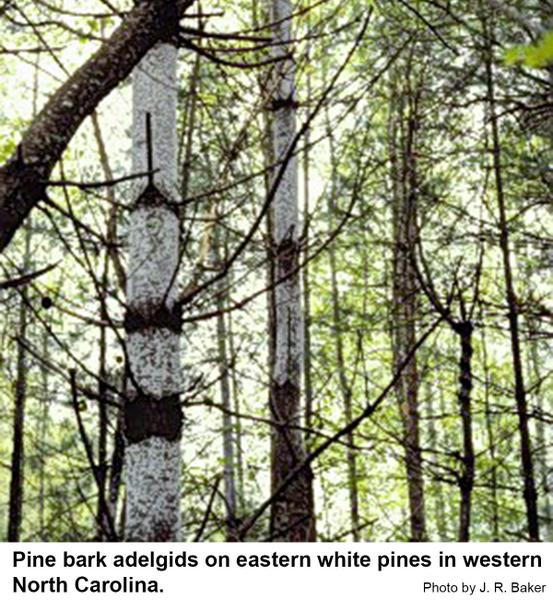General Information
Adult pine bark adelgids, Pineus strobi, are small, dark (purplish to yellow) insects covered with a white, flocculent material. Eggs are milky to light yellow-brown but as the embryo matures, the eggs darken. Nymphs resemble but are smaller than adults. At first naked and yellow, newly hatched nymphs soon darken and begin to secrete white, fluffy threads. Adelgids are among the most commonly reported insect pests of white pines. Pine bark adelgids can overwinter in all stages, though mostly as immature females. In late winter, development resumes, and each female lays up to 24 eggs in a woolly mass. After laying her eggs, the female dies. From these eggs develop both winged and wingless forms. Of the several different forms of immature adelgids (a characteristic of phylloxerids), only the crawler stage and winged forms are capable of migrating. The stationary wingless forms continue to reproduce parthenogenetically all season. There are five or more generations per year. In late winter and early spring, pine bark adelgid populations can become exceedingly abundant, but as soon as the weather warms up and syrphid maggots, lace wings, lady beetles, and other predators become active, adelgid populations usually crash to very low levels.
Host Plants
Found principally on white pine, the pine bark adelgid occasionally infests Scots, Austrian, and other pines. PIne bark adelgids are more unsightly than injurious on older trees, but they may seriously damage newly planted trees in landscapes. The needles of heavily infested saplings turn yellow. Small trees may be stunted or killed.
Residential Recommendation
Maggots of hover flies and other flies and lady beetle larvae feed on pine bark adelgids in warm weather. Trees that are heavily infested and are showing symptoms of decline should probably be sprayed for adelgid control. Horticultural spray oil can be applied during the winter and before new growth emerges in spring. Pine bark adelgids are not resistant to pesticides. Insecticidal soaps are very effective as are horticultural oils (oils may remove the white wax from the needles of white pines, turning them a sickly, yellowish green). Oil sprays may damage white pine during the growing season, especially in dry weather. Systemic insecticides such as imidacloprid are also effective as are pyrethroid and other contact insecticides.
| Pesticide (Trade Name) | Formulation | Remarks |
|---|---|---|
| *imidacloprid (Merit) | 75 % wettable powder | follow label directions |
| *oil, summer or horticultural | 98 to 99 % emulsifiable concentrate | 2 1/2 to 10 tablespoons per gallon of water |
| *soap (Insecticide Conc., M-Pede) | 50.5 % emulsifiable concentrate | 4 ounces per gallon of water |
* Suitable for home use.
Other Resources
- Insect and Related Pests of Shrubs. Baker, J. R. ed. 1980. NC Agr. Extension Service pub. AG-189. 199 pp
- Pine Bark Adelgid In Vera Krischik, V. and J. Davidson. 2013. IPM (Integrated Pest Management) of Midwest Landscapes. Univ. Minnesota, Center for Urban Ecology and Sustainability.
- NC State Extension Plant Pathology Publications
- NC State Extension Horticultural Science Publications
- North Carolina Agricultural Chemicals Manual
For assistance with a specific problem, contact your local N.C. Cooperative Extension center.
Publication date: Dec. 3, 2013
Reviewed/Revised: Oct. 10, 2019
Recommendations for the use of agricultural chemicals are included in this publication as a convenience to the reader. The use of brand names and any mention or listing of commercial products or services in this publication does not imply endorsement by NC State University or N.C. A&T State University nor discrimination against similar products or services not mentioned. Individuals who use agricultural chemicals are responsible for ensuring that the intended use complies with current regulations and conforms to the product label. Be sure to obtain current information about usage regulations and examine a current product label before applying any chemical. For assistance, contact your local N.C. Cooperative Extension county center.
N.C. Cooperative Extension prohibits discrimination and harassment regardless of age, color, disability, family and marital status, gender identity, national origin, political beliefs, race, religion, sex (including pregnancy), sexual orientation and veteran status.




